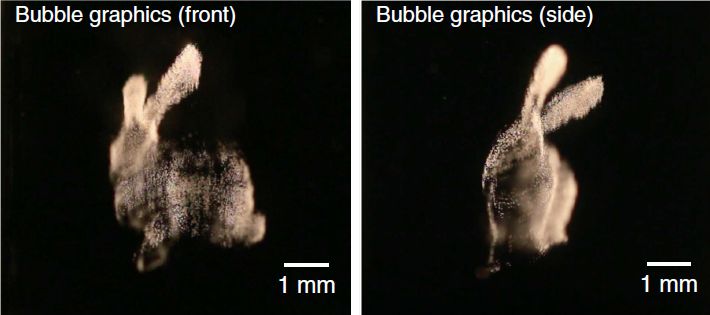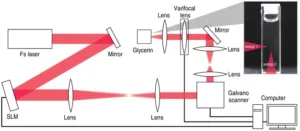A team of optical engineers led by Yoshio Hayasaki at Center for Optical Research and Education at Utsunomiya University (Utsunomiya, Japan) has developed a new kind of volumetric display in which the voxels forming the 3D image are created in a liquid by the generation of light scattering microbubbles. The researchers call their new display a volumetric bubble display.
A recent article on this subject published by the researchers is entitled “Volumetric bubble display.” It was published in Optica, Vol. 4, Issue 3, pp. 298-302 (2017). A copy of the article is available here.
The display utilizes a femtosecond pulsed laser in which the light is focused to a specific point within the volume of a glass cell filled with glycerin. The means by which the beam is focused includes the use of a varifocal lens. At the focal point, photons are absorbed creating microbubbles. The number of microbubbles created depends, in part, on the energy in the laser pulse. The position of the focal point within the liquid can be scanned by means of a 2D galvano scanner and a schematic of the prototype system appears in the figure below.
Configuration of the prototype volumetric bubble display.
The system increases the number of voxels that can be written per unit time by addressing focal points in parallel. The means by which this is accomplished is called holographic laser drawing and is based on a computer generated hologram displayed on a liquid crystal on silicon spatial light modulator. This drawing method can increase the light intensity of the microbubble voxels not only by increasing the number of voxels written but also because it is able to control the sizes and shapes of the voxels. Various beam shapes can be produced, such as a line focused beam.
The figure below shows an example of a 3D bubble graphic viewed from different observation directions.
 Two views of a volumetric graphic rendered by laser induced microbubbles.
Two views of a volumetric graphic rendered by laser induced microbubbles.
The article explains that the team’s new approach can successfully address certain limitations experienced by the approaches used in prior art volumetric display systems. That is, however, not to say that the new approach does not present its own technical challenges.
One challenge in the design of the volumetric bubble display was the fact that, as soon as the microbubbles form, they start to rise. This is due to the density of the gas in the bubble being much less than the density of the liquid. This issue was successful addressed by the use of a liquid with a viscosity that was high enough to sufficiently slow the rise of the microbubbles.
The team reported on the generation of microbubbles formed by single and multiple laser pulses. In the case of a single pulse, the generation area along the axial direction increased as the pulse energy increased. Multiple pulses increased not only the length but also the diameter of the microbubbles. These effects can be used to vary the contrast of the displayed graphic by changing the number of laser pulses.
The volumetric bubble display was demonstrated as capable of producing a high resolution, refreshable, grayscale volumetric display. In addition, the volumetric bubble display has a wide angle view and needs no addressing wires, since the transparent liquid is accessed optically.
One means for generating a full color display was demonstrated. It was created by illuminating the liquid volume with a projector that time sequentially produced red, green and blue light synchronized with the laser addressing that produces the image. Other means of producing a full color image were also discussed in the article.
The team suggests that the volumetric bubble display is most suited for public facilities such as a museum or an aquarium because, currently, the system setup is big and expensive.
At this time, the team has identified one principle problem with the volumetric bubble display. The bubbles do not dissipate in a sufficiently short time. The team is working on an updatable display system that would use a stream inside the liquid to burst the bubbles, allowing them to be cleared. Beyond this specific technical problem, the team hopes to reduce the size and cost of the laser source and optical devices so as to create a smaller system that might be affordable for personal use. -Arthur Berman
Utsunomiya University, Yoshio Hayasaki, [email protected]

